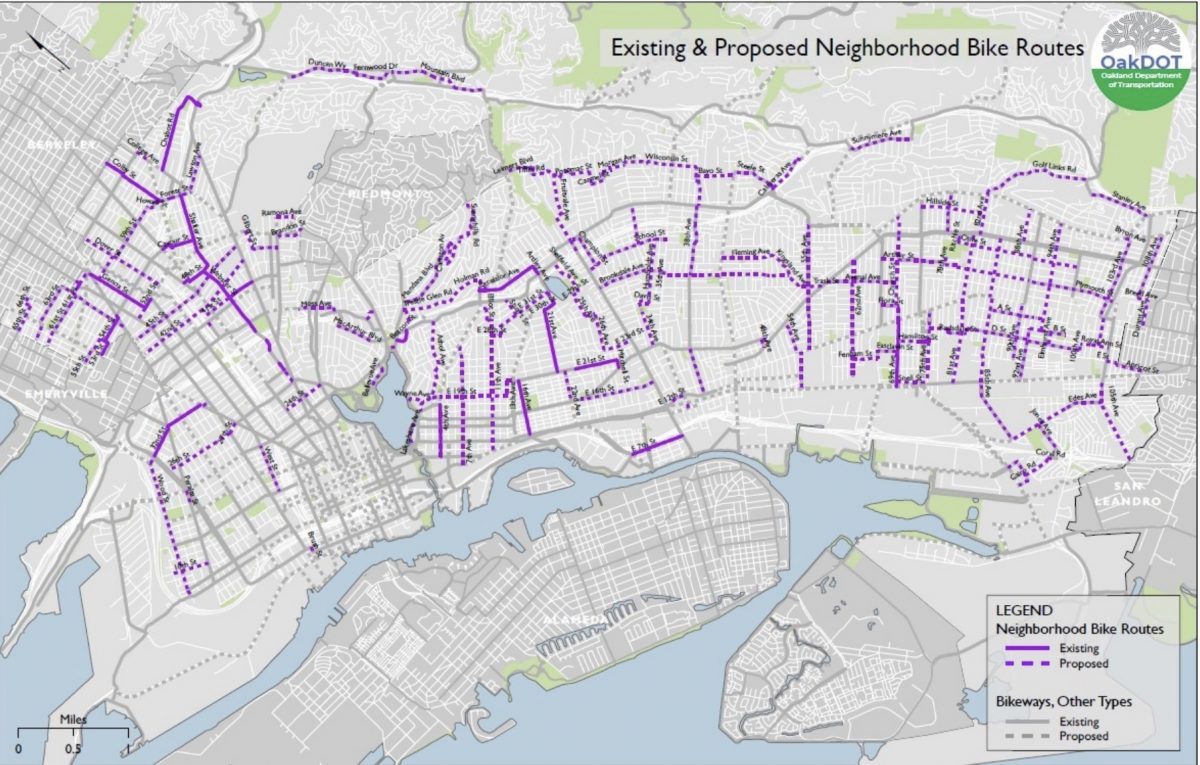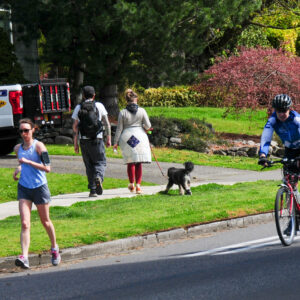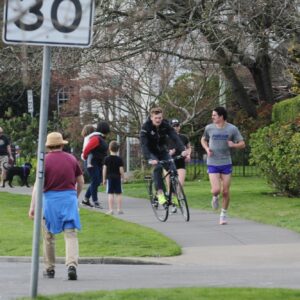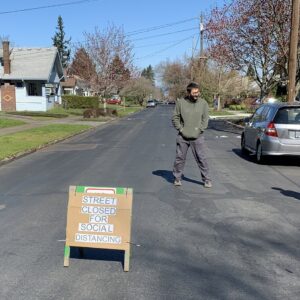
(Photo: City of Oakland)
As the City of Portland continues to ponder what — if anything — they’ll do to adapt streets to the Covid-19 outbreak, Oakland residents are already enjoying the fruits of their city’s decision.
On Friday we shared how the Mayor of Oakland had a much different reaction than Portland Mayor Ted Wheeler to the dramatic shifts in road usage and need for safe social distancing.
Oakland’s effort started Saturday with temporary barricades and cones being erected on a handful of streets. The city’s transportation department has also laid out details of their plans on their website. As I read through them, I was amazed at how many of the ideas mimic what we’ve been highlighting in the past month.
To refresh, Oakland plans to change 74 miles of neighborhood streets — about 10% of the city’s total — into “Slow Streets” where through driving traffic is no longer allowed. Based on photos from Oakland DOT, the changes are being made with barricades, traffic cones and the standard, “Road Closed to Through Traffic” signs placed at the beginning of each block.
The idea is to, “Discourage drivers from using Neighborhood Bike Routes unless necessary to reach a final destination… [so] that people can more comfortably use these low-traffic streets for physically distant walking, wheelchair rolling, jogging, and biking all across the City.”
There are four things that stand out to me in Oakland’s plan:
⇨ First, instead of worrying about how the public might misinterpret the changes, they’ve taken control of the messaging from the get-go. The writing on their website lays out the problem, avoids buzzwords and explains their rationale in clear and direct language. They are also explicit about what the plan doesn’t do: include police enforcement, limit emergency or transit vehicle access, or allow public gatherings of any size.
⇨ Second, they make it clear that the implementation of the changes is being done with existing social and economic disparities in mind. “The City will prioritize posting signage on routes in underserved communities,” their website reads. OakDOT also points out the fact that the virus crisis makes existing inequities — like low-wage earners and people unable to work from home or neighborhoods that have no park space — worse. “OakDOT seeks to reduce barriers to opportunities for physical activity and ensure safe transportation for our most vulnerable community members.”
⇨ Third, OakDOT is empowering the community to help. They tell people to download a new sign (not yet available) and post it along Slow Street corridors and spread the #OaklandSlowStreets messages on social media.
⇨ And finally, what I like about Oakland’s approach is that they’re not re-inventing the wheel. Instead of using the excuse that they don’t have time for a typical public outreach process, the Slow Streets effort relies on an existing plan that’s already been adopted. In their case it’s the Oakland Bicycle Plan and the routes they plan to change are part of the recommend bicycling network. Portland has a successful, well-connected, 100-mile, citywide neighborhood greenways network that — as suggested here in an opinion piece last month — could provide a similar foundation.
Advertisement
I’m hopeful that PBOT and Commissioner Chloe Eudaly’s staff are looking closely at Oakland’s efforts. While they are much denser than we are and they have a “strong mayor” form of government (thus making it easier for big things to happen quickly), Oakland looks like it could be a great model for us.
It’s worth noting that Mayor Ted Wheeler just issued a vague tweet about an hour ago, four days after his first comments on the topic on Thursday (after which he was hounded by Portlanders disappointed with his stance).
“We will continue to adjust and adapt to what’s in the best interest of public health,” he wrote. “Please continue to follow our Commissioner in charge of PBOT, @ChloeEudalyPDX, as well as @PBOTinfo for the latest updates. More to come.”
We hope so!
Read more about the Oakland Slow Streets program here. Also, there’s a free webinar coming Wednesday from the National Association of City Transportation Officials (NACTO) on, “How street design and policy can support public health goals during the coronavirus emergency.”
— Jonathan Maus: (503) 706-8804, @jonathan_maus on Twitter and jonathan@bikeportland.org
— Get our headlines delivered to your inbox.
— Support this independent community media outlet with a one-time contribution or monthly subscription.













Thanks for reading.
BikePortland has served this community with independent community journalism since 2005. We rely on subscriptions from readers like you to survive. Your financial support is vital in keeping this valuable resource alive and well.
Please subscribe today to strengthen and expand our work.
The city should really do something about the St. Johns Bridge…or is that managed by ODOT? In any case, it’s impossible to socially distance on the sidewalks and riding or walking on the bridge deck is taking your life in your hands. Would love to see it go to one lane each way for the duration of the pandemic – it’s not like there’s any traffic now anyway – with the extra lane for muscle-powered transportation.
Tell me about it. I haven’t even harangued ODOT at all because I doubt they would lift a finger on streets/bridges they manage and I’ve been keeping the focus on PBOT. I agree with you 100% about the St. Johns Bridge. The stakes there are very high because if you step off that sidewalk… well… anything could happen.
It makes me very sad to say this, but in my experience with ODOT it would be a waste of time to ask them to do anything innovative or nimble if it reduces space for car drivers.
It could/should be such a marquee facility for pedestrians and cyclists, it’s a crying shame. I should probably stop using it entirely, but the views keep me coming back.
Jonathan, I agree you asking ODOT to do anything is pointless and a waste of your time. On the other hand, in my experience in East Portland, asking your state legislator(s) to do the same has a much better chance of bearing fruit. ODOT to them is a bit like PBOT to city councilors.
I moved from Portland to SLC a few months ago, and now we’re planning on closing some streets to cars as well during this time (http://twitter.com/slcmayor/status/1249755005172633602). If Salt Lake can do it, Portland should be able to as well! PDX is really is lagging behind the curve here!
Portland has been lagging way behind the curve for a good 15 years now, and certainly since we received that absolutely useless ‘Platinum’ designation courtesy of the dishonest and corrupt League Of American Bicyclists. Which is partly why there isn’t enough energy or nimble, creative thinking to access in times like this. Chloe simply does not have the background or knowledge to make waves at PBOT and has virtually no overarching vision regarding transportation (housing yes – don’t get me started). The current PBOT Director is so bland and uninspiringly bureaucratic that nobody I know even knows his name. These are exactly the kind of un-radical transportation thinkers who won’t seriously get in the way of a billion-dollar freeway expansion despite the grim future bearing down on us, let alone set aside under-utilized road space for human-powered, well-spaced transport during a pandemic. It all feels so predictable by now. It’s sad but I see no obvious end to the situation other than some sort of power vacuum where people can simply take over and redesign the streets ourselves without immediate consequences from “the authorities”. The last few weeks have revealed some yawning cracks in the edifice…
I agree. My assumption is that Commissioner Eudaly isn’t and hasn’t been a vulnerable road user to any extent and doesn’t understand or care about our concerns. I feel like she is treating us all like a bunch of wealthy and privileged people who don’t understand the real problems in the city like she does. Her actions over the last few years show that she holds grudges and is unwilling to move off her hardened positions. People need and want space to recreate. The paths that parallel NE Marine Drive were packed with people on Sunday. There were probably 30 cars parked along the road by the I-205 bridge, I’ve never seen it that crowded.
Yes. I don’t consider myself to be strongly on either end of the spectrum (for example, I support frequent diverters on neighborhood greenways and repurposing a lane on Barbur for ped/bike traffic over the viaducts, but also would not support removing lanes on Powell). Hence, if somebody could give me a coherent argument against closing streets right now I might listen, but Eudaly’s “now is not the time” non-argument is just lacking in common sense and I haven’t seen a single coherent argument against temporary repurposing.
AndrewN allegedly wrote: “It’s sad but I see no obvious end to the situation…”
I do: we need to end Portland’s ridiculous commissioner-run form of government, which allows amateurs like Eudaly not only to have legislative oversight of gov’t agencies but actually RUN THEM.
It’s like electing the owner of a used bookstore to fly your 737 jet airplane and then expect to land safely in Chicago.
Portland has become THE CITY THAT CANNOT WORK b/c the commission form of gov’t is holding us back and not allowing us to address the challenges we face. Every decision has to please a hundred different constituencies, and city employees can’t do anything b/c they lack clear direction that shifts with the political winds. It’s ridiculous.
I never thought I’d say Oakland is ahead of us, but here we are.
Thank you for publishing this. It was very useful checking out the City of Oakland website, especially as my own community is trying to implement a series of pop-up bike lanes. While we would love to do what Oakland is doing (and that Portland could potentially do), unfortunately our own local community bike plan that was adopted by our council in 2016 has no local community bike routes in it. Instead, it relies entirely on bike lanes, sharrows, and protected bike lanes on arterial and collector streets – clearly an operational gap that needs fixing, but for now the plan we have is the one we’ll have to use.
The listing they have for the “why” of doing it is especially well-written and thought-out – what we need to convince our conservative city councilors and the even more conservative city manager and department engineers.
If street racers can shut down the upper deck of the Fremont Bridge while they spin donuts (and not a cop in sight), why don’t bicycle riders and walkers shut down any other street by simply doing it?
Differential threats? Street racers are recklessly endangering everyone around them, so people will stop and stay away when they see that driving. They will also physically threaten anyone who tries to stop them.
If you stick some cones at the end of your street, it’s really easy for someone in a Land Rover to just mow them down and keep driving down the street. Building safe spaces can be hard; destroying them is easy.
True. But also, cones are just not robust enough to do the job. The diverters at SE Clinton and 32nd started as a guerrilla installation by anonymous residents. Fill some barrels or cattle troughs with soil or concrete to partially block the street and you will see a much higher compliance rate than you will with cones and signs.
That being said, people are more likely to drive around your jerry-rigged diverters than they are to try to challenge a couple hundred street racers doing donuts on the Fremont Bridge. This fact is obvious, as many people drive right around the handful of diverters that PBOT has actually managed to install over the years. But large, physical diverters do discourage cut throughs from the vast majority of people in cars.
And yes, someone could just go out there and remove your guerrilla diverter. But most people are too lazy to get out of their car.
“Why don’t bicycle riders and walkers shut down any other street by simply doing it?”
That’s exactly what’s happening in Portland and all over the country, where’s enough social cohesion in the immediate area to support it. Folks are putting up block-party-like barriers just up the street from me here in Buckman. Here’s an example in DC: https://ggwash.org/view/77102/frustrated-dc-residents-are-widening-sidewalks-themselves.
I strongly support such approaches, but I don’t think they’re viable solutions for where there’s significant bicycle traffic. Neighbors are probably less likely to intervene in the road space, even though they may want to. That’s where the city should take action, especially in the denser parts of town, like NW.
Slippery slope – other people are doing something illegal, so why don’t I?
Keep the pressure on, Jonathan!
We should have had frequent, permanent diverters on every single neighborhood greenway years ago. This is the perfect time to push PBOT to do the right thing.